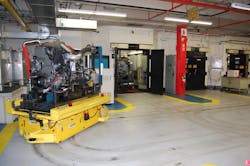Dan Arcy, global OEM technical manager for the Americas for Shell Lubricants, will tell you that the new CK-4 and FA-4 diesel engine oil blends due for release December 1 – the end result of five years’ worth of work – weren’t just designed to help 2017-model engines comply with stringent Phase 2 greenhouse gas (GHG) fuel economy mandates.
Also driving the need for these new formulations is the recognition that truck engine designs as a whole are now vastly different compared to previous decades, he explained to Fleet Owner, offering an opportunity to bring thinner viscosities and new protective “additive packages” to the market.
“We knew some of the [engine] tests we’ve been using to validate out oil formulations had to go away as well,” Arcy pointed out. “There simply weren’t parts available for 20 year-old tests. So we really had a chance here to update everything.”
He said work began on Proposed Category 11 or “PC-11” oils back in June 2011 in three distinct “phases,” with the recognition that regulations – specifically the new GHG rules – would be the driving force behind new formulations.
Yet the industry representatives from engine manufacturers, chemical companies, and oil marketers who gathered to form a nine-member “evaluation team” for the new PC-11 oils also saw it as an opportunity to do other things as well, such as add requirements necessary to meet so-called “renewable fuel” standards.
The key difference between PC-11 and all the other categories preceding it revolves around the creation of “two sub-categories” within the standard, Arcy said: one that created oils with viscosities equivalent to current formulations, which became CK-4, and another for thinner viscosities aimed at helping improve fuel economy in newer engines, which became FA-4.
Dr. Jason Brown, global technology manager for heavy duty diesel engine oil (HDDEO) at Shell, said that PC-11 is "not the first time" a so-called "split category" for engine oils has been developed, but it is the first time two "sub-categories" have been launched at the same time: the two subcategories, again, being CK-4 and FA-4.
Shawn Whitacre, senior staff engineer primarily responsible for product formulation of Delo heavy duty engine oils for Chevron Product Co., served as the chairman of the American Society for Testing and Materials [ASTM] heavy-duty engine oil classification panel that developed the PC-11 oil requirements.
Shell’s Arcy added that the “first phase” of the evaluation panel’s job centered on establishing what criteria both of the new oils needed to address and whether enough “supporting data” existed to go forward with formulation requirements meeting those requirements.
“We add to ask ‘what is the rationale?’ for meeting a new requirement,” Arcy said. “Better oxidation control, for example, was an easy one because we knew the new [2017] engines would run hotter than previous models by about 10 degrees Celsius,” which is roughly 50 degrees Fahrenheit hotter.
The reason for tighter shear stability requirements, however, revolved around a smaller yet critical factor.
“In this case, the rational is that we found some 15W-40 oils were ending up as 15W-30 over time in the crankcase,” Arcy pointed out. “That wasn’t an engine wear concern but an oil analysis concern; it would be harder to spot fuel dilution. So we had to tighten up the pass/fail criteria for shear stability.”
Another new twist: the need for new tests regarding the impact of biodiesel fuels. Arcy said when biodiesel began to be introduced widely in trucking back in 2006, it acted as a “solvent” of sorts, “cleaning out” fuel tanks of deposits which led to the plugging up of injectors and fuel filters.
He noted that the team’s examination found that there are today fewer problems related to “plugging” but that a test to ensure oils would be “biodiesel compatible” would be a good thing.
All in all, Arcy emphasized that the “first phase” of the PC-11 development process – establishing the requirements and tests the new oils needed to meet – took six months to complete, with “strong support” to develop two separate “sub categories” of engine oils.
“These were all open meetings, so it wasn’t just the nine members in a room; we had routinely 50 to 100 others in attendance,” he explained. “We also made all of our decisions through a ‘consensus process,’ as we all had different experiences to share,” Arcy stressed. “Remember too this was a technical committee, making decisions based on technical data – not commercial needs. Take oxidation, for example; we had to define a minimum standard for product reference. That also gave us a chance to take a ‘fresh look’ at those standards to make sure they made sense.”
Tomorrow in part two we’ll look at the “phase two” testing process for the new oils and the final “phase three” licensing process that the industry is now rapidly completing.
About the Author
Sean Kilcarr
Editor in Chief
Sean Kilcarr is a former longtime FleetOwner senior editor who wrote for the publication from 2000 to 2018. He served as editor-in-chief from 2017 to 2018.


